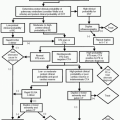Spinal Cord Compression
Azar P. Dagher
Andrew L. Holz
Spinal metastasis and epidural abscess are the most common entities that can cause spinal cord compression in addition to trauma and degenerative disease.
Spinal Metastasis
Source.
Approximately 70% of spinal tumors are metastatic in origin. The most common tumors associated with spinal cord compression are lymphoma and multiple myeloma (together accounting for approximately 19% of cord compression cases), metastatic lung cancer (17%), metastatic breast cancer (12%), metastatic genitourinary malignancies (11%), and metastases from an unknown primary (12%). Renal cell carcinoma and malignant melanoma also commonly metastasize to the spine and can cause spinal cord compression.
Location.
Ninety percent of spinal metastases are extradural. Intramedullary metastases are rare. To cause cord compression, tumor typically invades the anterior epidural space from the adjacent vertebral body. Lung and breast cancer tend to metastasize to thoracic levels. Prostate cancer and renal cell carcinoma tend to metastasize to lumbosacral levels. Melanoma has no preference for spinal level.
Epidural Abscess
Source.
Risk factors include age, IV drug abuse, spinal procedures, altered immune status (e.g., diabetes mellitus), and malignancy. Staphylococcus aureus is the most common organism, and is found in approximately 60% of cases. The incidence of epidural abscess is approximately 0.2-2.0 per 10,000 people.
Location.
Most patients are infected through the hematogenous route. Most commonly the abscess begins as a focus of spinal discitis/osteomyelitis and enlarges to cause cord compression. Iatrogenically introduced bacteria can also cause these abscesses. The level of involvement is cervical in 25% and lumbosacral in 38%. The abscess is anterior in 50% and circumferential in 33%.
Symptoms and Signs.
Early symptoms of spinal cord compression are back pain with or without a radicular component. Fast growth of tumor or abscess generally causes pain; slow growth causes weakness and other cord compressive signs. Hyperalgesia suggests nerve root involvement. In the evolution of symptoms and signs, motor loss occurs before sensory loss because of the anatomy of the tracts of the cord. Decreased strength results from compression of anterior horn cells. Posterior compression affects the posterior spinocerebellar and lateral spinothalamic tracts, manifesting as decreased posture appreciation, ipsilateral decreased vibration sensation, and contralateral decreased pain and temperature sensation. Incontinence occurs late in the course of cord compression, with urinary incontinence preceding rectal incontinence, and signifies that reversal of symptoms with therapy is unlikely.
If the cord compression is due to an epidural abscess, fever and obtundation are often present in addition to the neurologic deficits. When deterioration occurs rapidly, it is often secondary to the infection and inflammation causing venous thrombosis resulting in cord ischemia.
Level of Involvement.
The level of cord involvement can be predicted from the level of vertebral involvement and vice versa. Analysis of dermatomes is commonly used to determine the level of cord involvement.




